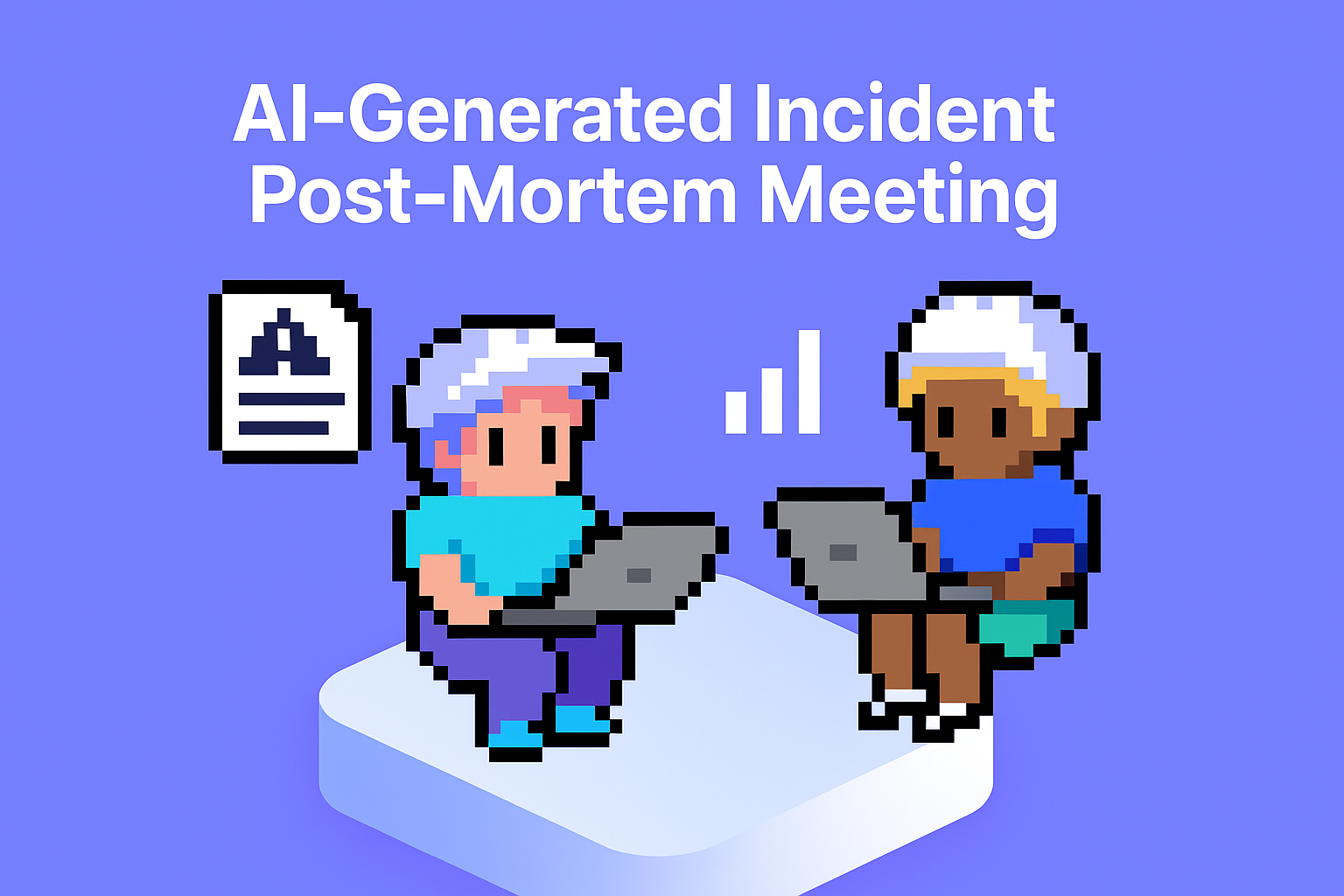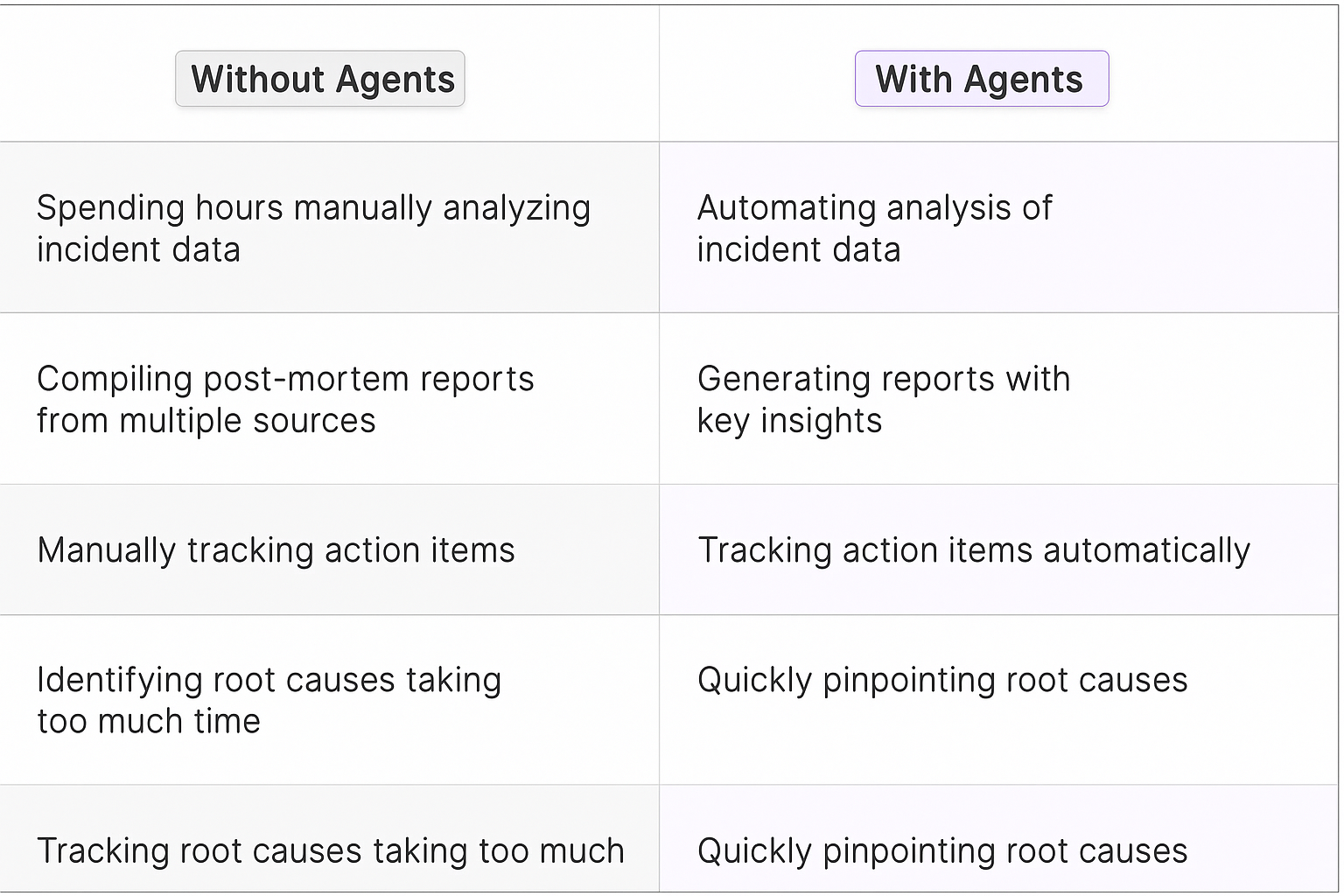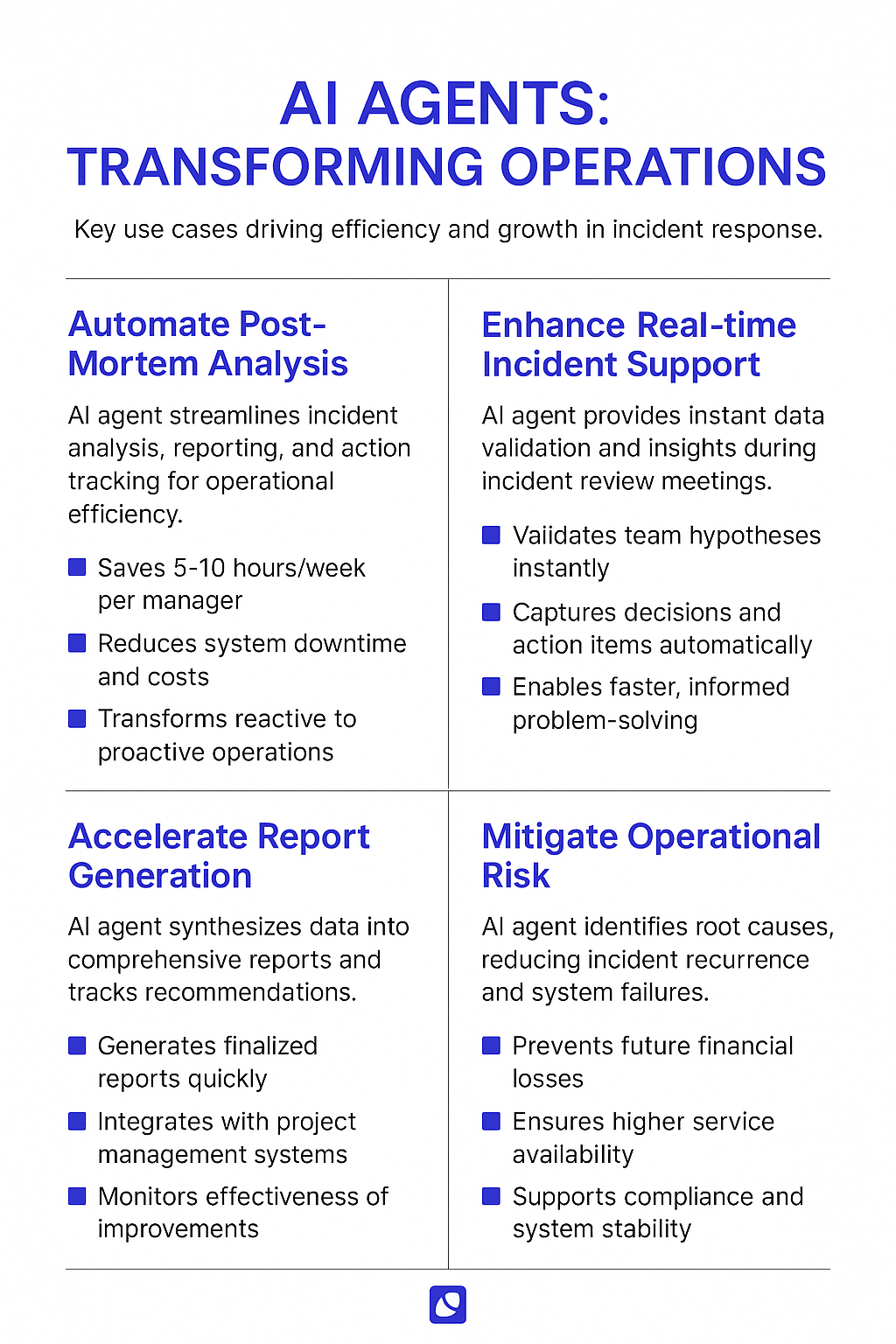
AI-powered incident response post-mortem meeting agents are transforming how Operations Technology Managers analyze incidents, collaborate with teams, and improve system resilience. These agents automate the tedious aspects of data analysis and report generation, allowing managers to focus on strategic decision-making and preventative measures. This technology streamlines workflows, reduces response times, and enhances overall system stability.
Before Meeting
Your AI agent automatically gathers all relevant incident data, including logs, alerts, and response timelines. It identifies potential root causes and generates a preliminary report for review, ensuring you're well-prepared for the meeting.
During Meeting
As the team discusses the incident, your AI agent provides real-time data analysis and insights, helping to validate findings and identify areas for improvement. It captures key decisions and action items, ensuring everyone is aligned on next steps.
After Meeting
Post-meeting, your AI agent generates a final post-mortem report with actionable recommendations. It tracks the implementation of these recommendations and monitors their effectiveness, ensuring continuous improvement in incident response.
What you’ll need
You don't need to be a developer to set up this integration. Follow this simple guide to get started:
- Meeting Notetaker Agent template
- Calendar account
- Meetings to join
- Relevance AI Account

Who this agent is for
This agent is designed for Operations Technology Managers, IT Directors, System Administrators, DevOps Engineers, and anyone involved in managing and maintaining complex technical systems. It's ideal for individuals and teams who regularly conduct post-mortem meetings to analyze incidents, identify root causes, and implement preventative measures. Whether you're managing a small IT infrastructure or a large-scale cloud environment, this agent simplifies the post-mortem process and ensures continuous improvement in incident response.
How this agent makes meeting planning easier
Automate data collection and analysis
Instead of manually gathering and analyzing incident data, the agent automatically collects relevant information from various sources, such as logs, alerts, and monitoring systems. This saves significant time and reduces the risk of human error.
Generate comprehensive post-mortem reports
The agent automatically generates detailed post-mortem reports with key findings, root causes, and actionable recommendations. This eliminates the need for manual report writing and ensures consistency across all post-mortem analyses.
Facilitate collaboration and knowledge sharing
The agent provides a centralized platform for teams to collaborate on incident analysis and share knowledge. This improves communication and ensures that everyone is aligned on the lessons learned.
Track the implementation of recommendations
The agent tracks the implementation of recommendations and monitors their effectiveness, ensuring continuous improvement in incident response. This helps to prevent similar incidents from occurring in the future.
Benefits of AI Agents for Operations Technology Managers
What would have been used before AI Agents?
Operations Technology Managers traditionally relied on manual data collection, spreadsheet analysis, and lengthy email threads to conduct post-mortem meetings. This process was time-consuming, prone to errors, and often resulted in incomplete or biased analyses. They would spend valuable time sifting through logs, creating reports, and coordinating with various teams, taking away from their core responsibilities of system maintenance and incident prevention.
What are the benefits of AI Agents?
AI agents offer a streamlined and automated approach to incident response post-mortem meetings, freeing up Operations Technology Managers to focus on strategic tasks. The most significant benefit is the time saved by automating data collection and report generation. The agent handles everything from gathering logs to identifying root causes, reducing the administrative burden on the manager.
AI agents also minimize bias by providing objective data analysis and identifying patterns that might be missed by human analysts. This ensures that post-mortem analyses are accurate and comprehensive. Furthermore, the agent improves collaboration by providing a centralized platform for teams to share knowledge and track progress.
By integrating with existing monitoring and alerting systems, the agent provides a seamless and user-friendly experience. This eliminates the need for manual data entry and ensures that all relevant information is readily available. Ultimately, AI agents enhance productivity, reduce stress, and allow Operations Technology Managers to focus on creating more resilient and reliable systems.
Traditional vs Agentic meeting planning
Traditionally, Operations Technology Managers spent hours each week manually analyzing incident data. Now, AI agents automate this, freeing up time for strategic planning. Before, creating a post-mortem report involved compiling data from multiple sources. With an agent, reports are generated automatically, with key insights highlighted. Tracking action items used to be a manual task, often overlooked. Now, they're tracked automatically, ensuring accountability. Identifying root causes was a time-consuming process. The agent uses machine learning to quickly pinpoint the underlying issues. Finally, sharing knowledge across teams was challenging. The agent provides a centralized platform for collaboration.

Tasks that can be completed by an Incident Response Post-Mortem Agent
Operations Technology Managers juggle numerous tasks, from monitoring system performance to responding to incidents and implementing preventative measures. An incident response post-mortem agent can handle many of the administrative tasks associated with analyzing incidents and conducting post-mortem meetings, allowing managers to focus on their core responsibilities.
Automating Data Collection
The agent automatically collects relevant data from various sources, such as logs, alerts, and monitoring systems, eliminating the need for manual data gathering.
Identifying Root Causes
The agent uses machine learning algorithms to analyze incident data and identify potential root causes, providing valuable insights for preventing future incidents.
Generating Post-Mortem Reports
The agent automatically generates detailed post-mortem reports with key findings, root causes, and actionable recommendations, saving significant time and effort.
Tracking Action Items
The agent tracks the implementation of recommendations and monitors their effectiveness, ensuring continuous improvement in incident response.
Facilitating Collaboration
The agent provides a centralized platform for teams to collaborate on incident analysis and share knowledge, improving communication and alignment.
Prioritizing Incidents
The agent can prioritize incidents based on their severity and impact, ensuring that the most critical issues are addressed first.
Predicting Future Incidents
The agent can use historical data to predict potential future incidents, allowing managers to proactively implement preventative measures.
Integrating with Existing Systems
The agent integrates with existing monitoring and alerting systems, providing a seamless and user-friendly experience.

Things to Keep in Mind When Building an Incident Response Post-Mortem Agent
Building an effective incident response post-mortem agent requires careful planning and attention to detail. The goal is to create an agent that seamlessly integrates with your existing workflows and provides valuable insights for improving incident response.
Define Clear Objectives
Before you start building your agent, define clear objectives for what you want it to achieve. Do you want to reduce incident resolution times, prevent future incidents, improve collaboration, or all of the above? Having clear objectives will help you prioritize features and measure success.
Integrate with Existing Systems
Ensure that your agent integrates seamlessly with existing monitoring and alerting systems, such as Prometheus, Grafana, and PagerDuty. This will make it easier for the agent to collect relevant data and provide timely insights.
Prioritize Data Security
Protect sensitive incident data by implementing robust security measures, such as encryption and access controls. Ensure that the agent complies with all relevant data privacy regulations.
Automate Report Generation
Configure the agent to automatically generate detailed post-mortem reports with key findings, root causes, and actionable recommendations. This will save significant time and effort.
Track Action Items
Implement a system for tracking the implementation of recommendations and monitoring their effectiveness. This will ensure continuous improvement in incident response.
Provide Customizable Settings
Allow users to customize the agent's settings to match their preferences. This might include setting preferred reporting formats, specifying data sources, and choosing which metrics to track.
Test Thoroughly
Before you roll out the agent to your entire team, test it thoroughly to ensure that it is working correctly and that it meets your objectives. Gather feedback from users and make any necessary adjustments.
Continuously Improve
Once your agent is live, continue to monitor its performance and gather feedback from users. Use this information to identify areas for improvement and make ongoing enhancements.
The Future of AI Agents in Meeting Planning
The future of AI agents in incident response post-mortem meetings is bright, with advancements in natural language processing, machine learning, and artificial intelligence promising to further streamline and enhance the analysis process. Future agents will be able to understand complex incident reports, anticipate potential conflicts, and proactively suggest solutions.
AI agents will also become more personalized, learning individual preferences and tailoring their recommendations accordingly. They will be able to identify preferred reporting formats, communication styles, and even preferred meeting times, creating a more seamless and user-friendly experience.
Furthermore, AI agents will play a larger role in facilitating collaboration and communication during meetings. They will be able to transcribe meeting minutes, track action items, and even provide real-time translation services, making meetings more productive and inclusive.
AI agents will also integrate with other business applications, such as project management tools and CRM systems, providing a holistic view of incident-related activities and enabling better decision-making.
Ultimately, the future of AI agents in incident response post-mortem meetings is about creating intelligent systems that not only automate the analysis process but also enhance collaboration, improve communication, and drive better system resilience.









